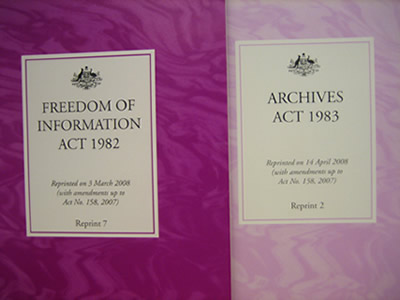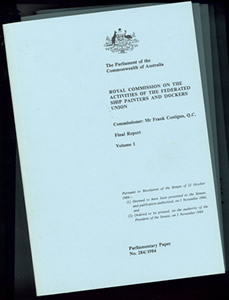166 Other methods of tabling documents
-
Other documents may be presented pursuant to statute, by the President, or by a minister.
-
If:
-
the President certifies that a document is to be presented to the Senate; or
-
a minister or the Auditor-General provides to the President, or, if the President is unable to act, to the Deputy President, or, if the Deputy President is unavailable, to any one of the Temporary Chairmen of Committees, a document which is to be laid before the Senate,
on the certification or the provision of the document, as the case may be:
-
the document shall be deemed to have been presented to the Senate;
-
the publication of the document is authorised by this standing order;
-
the President, the Deputy President, or the Temporary Chairman of Committees, as the case may be, may give directions for the printing and circulation of the document; and
-
the President shall lay the document on the table at the next sitting of the Senate.
Amendment history
Adopted: 19 August 1903 as SO 351 (corresponding to paragraph (1)) but renumbered as SO 347 for the first printed edition
Amended:
- [13 February 1991, J.738, as amended 27 May 1993, J.290 (paragraph (2) initially adopted as an order of continuing effect to provide for presentation of documents by ministers when the Senate is not sitting; amended to include presentation of reports by the Auditor-General)]
- 13 February 1997, J.1447 (to take effect 24 February 1997) (order of continuing effect adopted as paragraph (2))
- 7 December 1998, J.287 (modification of paragraph (2) to include documents certified by the President)
1989 revision: Old SO 361 renumbered as SO 166; terminology modernised by replacing “by Command of His Excellency the Governor-General” with “by a minister”
Commentary

The FOI and Archives Acts influenced the terminology used in the standing orders
If SO 165 is one of the least used standing orders, SO 166 is one of the most frequently invoked, both on sitting and non-sitting days when, by its authority (and that of SO 167 on sitting days), thousands of documents are presented to the Senate each year and authorised for publication.
Paragraph (1) was an original standing order, agreed to without debate in 1903. Unlike its South Australian and Victorian progenitors,[1] it also provided the President with the power to present documents (then referred to as “papers”) to the Senate. This power ensures that the President is able to keep the Senate appropriately informed about any matter coming to the attention of a presiding officer.
“Papers” was the original term of art used to refer to documents laid before the Senate and other Houses of comparable descent. Although “documents” was used as well, for example in SO 168, it was a less common term than “papers”. The ubiquity of the term “papers” was reflected in the title of the officer charged with their recording and custody (Clerk of the Records and Papers) as well as in the physical environment. Before there was a Table Office, there were a Bills and Papers Office and a Records Office. In 1908, there was a Parliamentary Papers Act conferring absolute privilege on papers and records printed for the Parliament by the Government Printer (see SO 43). The inquiry power of committees was phrased in terms of a power to call for persons, papers and records. There is still a Parliamentary Papers Series in existence.
While there may once have been a meaningful distinction between “papers” and “records”,[2] the terms became conflated in meaning and were overtaken by “document” as the dominant term which, in any case, was of broader application. In the wake of such major public interest immunity cases as Conway v Rimmer (UK) 1968 AC 910 and Sankey v Whitlam and others 1978 142 CLR 1, which concerned the disclosure of documents classified by the executive, and the development of statutory access regimes to public records in the 1980s,[3] “document” replaced “paper” in the 1989 revision of the standing orders as a more contemporary and meaningful term.
The categories of documents referred to in paragraph (1) provide a structure for the presentation of documents to the Senate on any sitting day. By convention, each afternoon, an opportunity for the presentation of documents pursuant to SO 166 is listed on the order of business (or “Senate Red”) for that day in the following terms:
15. Tabling of documents
-
By President
-
By ministers
-
By Clerk (delegated legislation including regulations, ordinances, determinations, rules, declarations and orders – a list will be circulated in the chamber)
In this example, the documents tabled by the Clerk are those presented pursuant to statute in the terms of the standing order. As indicated by the explanation, such documents largely comprise delegated legislation, most of which is subject to disallowance. Also see SO 63.
Ministers may table documents at any time but, for convenience, many such documents are presented at fixed times in the routine of business and dealt with in accordance with SO 61 (Consideration of government documents).
Standing order 38 provides the equivalent authority for the presentation of committee reports.

Authorisation for tabling documents and reports when the Senate is not sitting was first used for the report of the Royal Commission on the Federated Ship Painters and Dockers Union in 1984, it is now routine
A procedure for the presentation of committee reports when the Senate was not sitting had been used on an ad hoc basis for many years and became the subject of a sessional order (and later a standing order) in August 1990 (see SO 38). In its Second Report of 1990, the Procedure Committee recommended that the same principle should be applied to government documents to provide greater flexibility. It had been tried previously on one occasion in relation to the report of the Royal Commission on the Federated Ship Painters and Dockers Union in 1984 and had worked without any apparent difficulties.[4]
The committee’s report was adopted on 13 February 1991 and the first version of paragraph (2) came into operation as an order of continuing effect.[5] Two years later, the order was amended by adding Auditor-General’s reports to the classes of documents that could be presented out of sitting. The amendment was initiated by the government of the day and, in giving notice of the motion to amend the order, Senator Faulkner (ALP, NSW), then Manager of Government Business in the Senate, tabled correspondence from the Clerk recommending the amendment following representations from the Auditor-General. The inability of that officer to present reports during election periods or long adjournments was seen as an inconvenience that could be easily remedied by amending the order.[6] The amended order was incorporated into SO 166 by the 1997 consolidation.
One further change was made in 1998 to address an anomaly identified by the Procedure Committee in its First Report of 1998.[7] Under SO 166 the President could present documents to the Senate when it was sitting but, unlike ministers or the Auditor-General, did not have the authority to present documents when the Senate was not sitting. This meant that during election periods or long adjournments annual reports of parliamentary departments or other documents presented by the President (which then included reports of the Reserve Bank) could not be treated in the same way as government reports. The amendment to include documents presented out of sitting by the President was agreed to on 7 December 1998.[8]